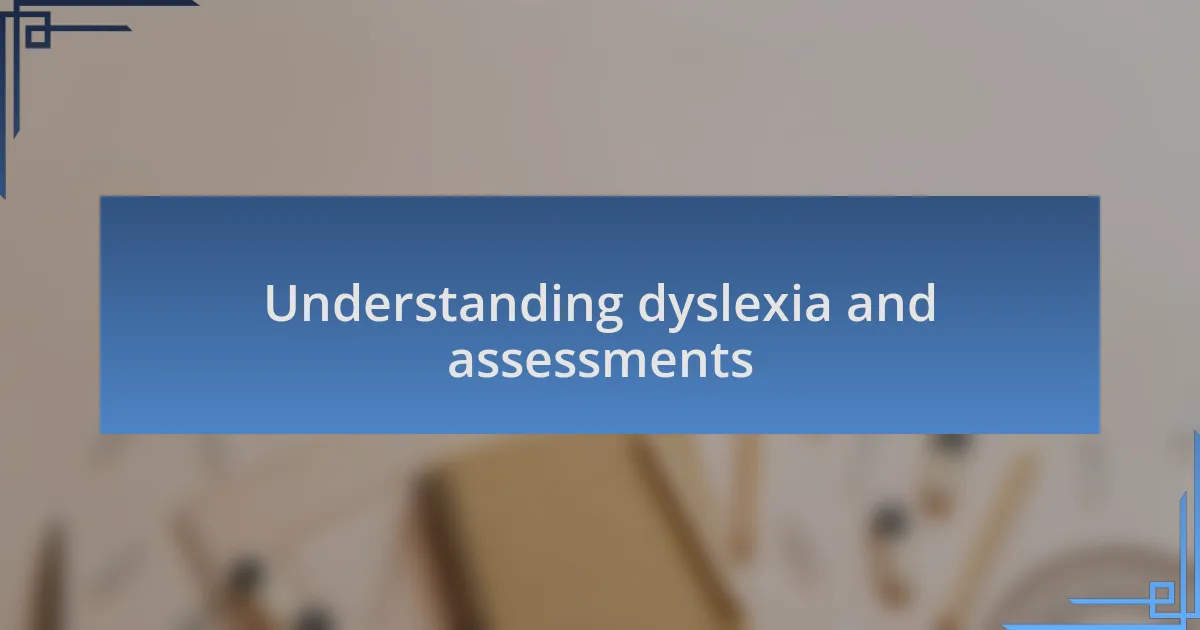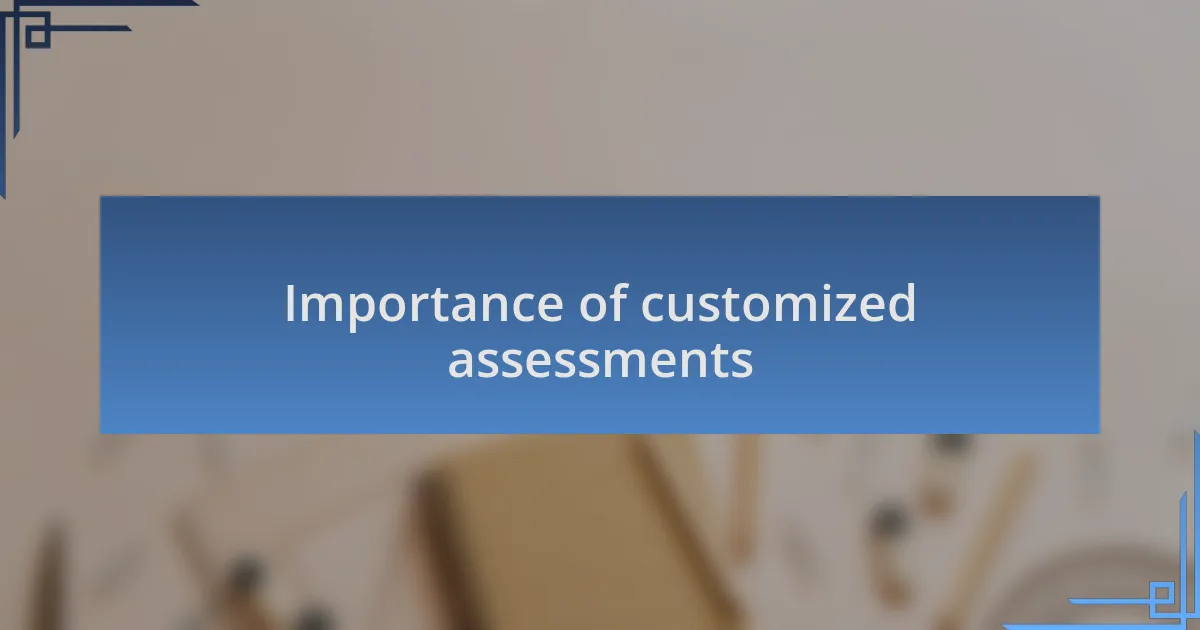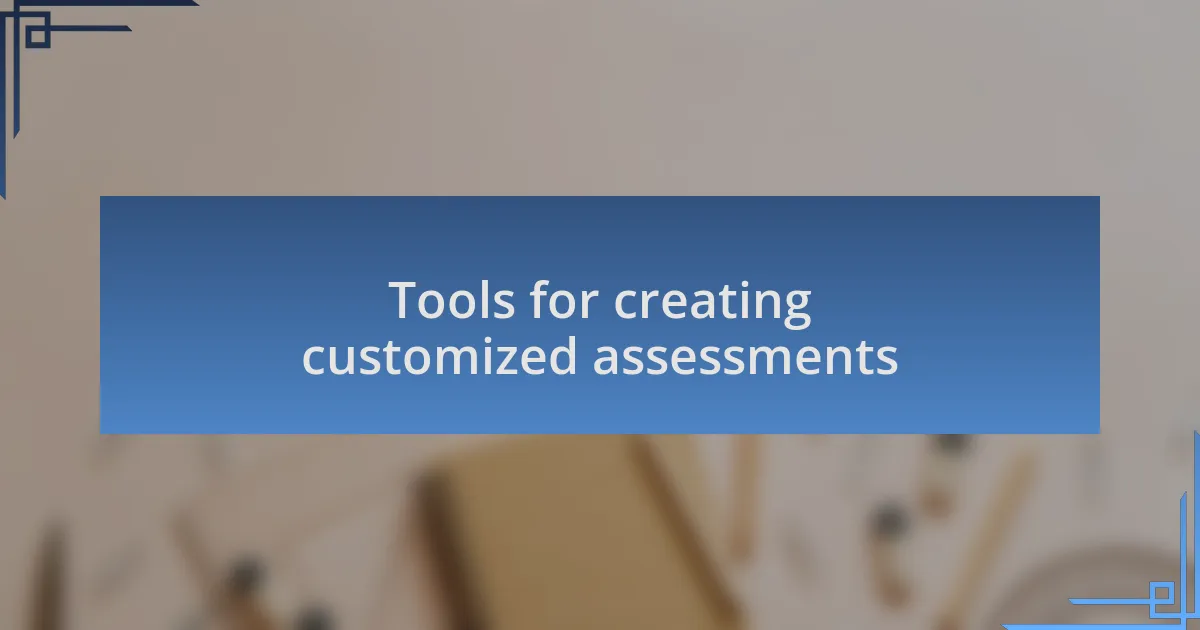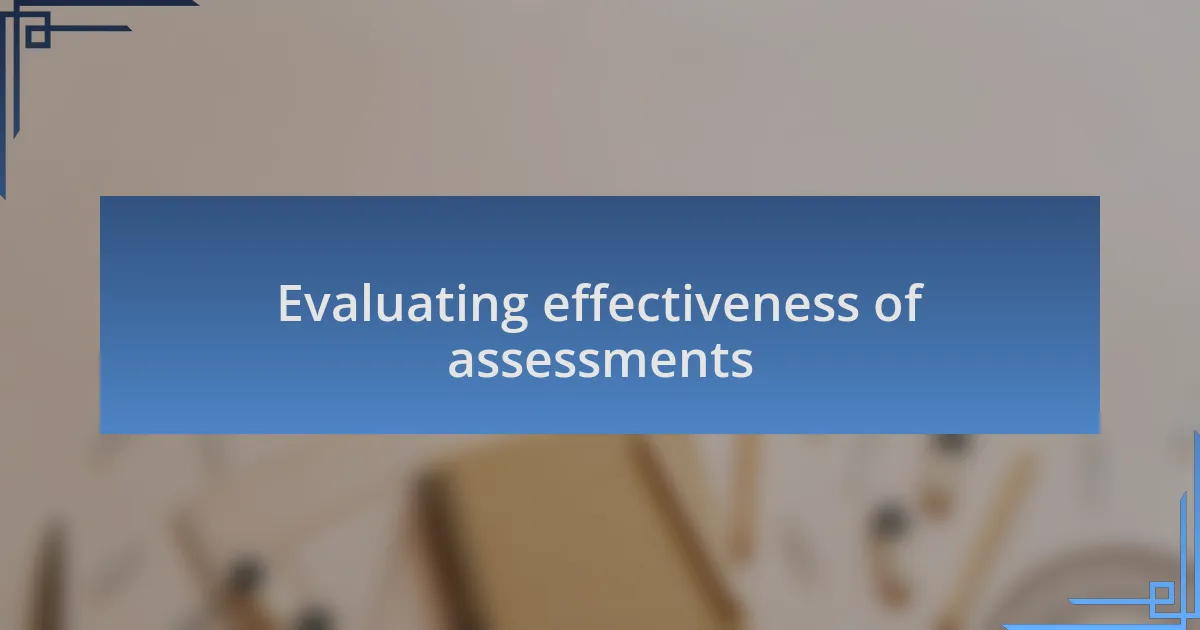Key takeaways:
- Understanding dyslexia involves recognizing the unique challenges learners face during traditional assessments, necessitating adaptations to reflect their strengths.
- Customized assessments, incorporating diverse formats and options, are crucial for accurately measuring learners’ capabilities and fostering their confidence.
- Continuous engagement and feedback from learners help identify their needs and preferences, allowing for more effective and personalized assessment strategies.
- Evaluating assessment effectiveness through feedback and diverse methods ensures they align with learners’ strengths and emotional well-being, enhancing overall learning experiences.

Understanding dyslexia and assessments
Dyslexia often presents unique challenges in how learners process language, which can greatly impact their performance on traditional assessments. I remember working with a student who struggled with standardized tests, not because of a lack of knowledge, but due to the overwhelming format that didn’t cater to their needs. How often do we stop to consider if our assessments truly measure understanding, or if they inadvertently highlight learning differences?
Comprehending dyslexia means recognizing that it isn’t just about reading difficulties; it’s about how individuals perceive and interact with information. I’ve witnessed the frustration on a learner’s face when they know the answer but can’t express it the way the assessment expects. This experience makes me wonder: are we creating barriers instead of pathways for these individuals?
It’s crucial to adapt assessments to reflect each learner’s strengths rather than solely focusing on their challenges. I’ve found that incorporating different formats—like oral presentations or interactive projects—can showcase a student’s true knowledge and creativity. Why not ask ourselves how we can cultivate an environment where every learner feels confident and capable, regardless of their reading style?

Importance of customized assessments
Customized assessments are vital for effectively measuring the capabilities of learners with dyslexia. I once worked with a young learner who excelled in storytelling. However, when it came to written exams, their creativity and knowledge seemed to vanish. It made me realize that standard assessment formats often overlook a student’s true potential. Are we doing enough to ensure these assessments reflect who our learners are?
When I tailored assessments by incorporating visual aids, I noticed a significant shift in engagement and performance. One student, usually disengaged during traditional quizzes, absolutely blossomed during a project that allowed them to express their ideas visually. It highlights the importance of customization: how can we expect standardized evaluations to capture the richness of individual understanding?
Ultimately, personalized assessments do more than just facilitate learning; they build confidence. I remember a student who once dreaded tests but thrived in a setting where they could use their strengths to express knowledge. Isn’t fostering confidence as crucial as measuring knowledge itself? By adjusting our evaluative methods, we can create not only better learners but also happier ones.

Identifying learner needs and preferences
Understanding the unique needs and preferences of each learner is crucial for effective assessment design. When I first started working with diverse learners, I quickly learned that one size does not fit all. For instance, one student loved hands-on activities, but standardized tests left them feeling frustrated and disconnected. How do we truly engage learners if we don’t take the time to identify what they need?
To identify these needs, I often use informal conversations and observations to gauge a learner’s preferences. Engaging them in discussions about their favorite ways to learn can unveil insights that traditional assessments might miss. I recall a moment when I asked a student how they liked to express their knowledge, and their eyes lit up as they spoke about creating podcasts. This conversation transformed our approach, leading to an assessment that not only met their learning style but also ignited their passion for the subject.
It’s essential to be attentive and adaptable, continually checking in with learners to understand their evolving needs. During a group project, I noticed one student thriving in collaboration while another preferred solitude. By recognizing these preferences, I could customize assessments that not only respected their differences but also encouraged their individual strengths. Isn’t it amazing how a little insight into a learner’s preferences can make such a significant difference in their educational journey?

Strategies for personalizing assessments
When it comes to personalizing assessments, I’ve found that using a variety of formats can truly engage learners. For example, I once designed an assessment that included options for written responses, oral presentations, and creative projects. Watching a student choose to build a model rather than write a paper was a game-changer for me; it highlighted how different assessment formats can tap into a learner’s strengths and interests. Why stick to traditional tests if we can let students shine in ways that resonate with them?
Another effective strategy I’ve used is incorporating choice into assessment topics. I once had a student who struggled with conventional subjects but thrived when given the opportunity to relate the material to their love for music. Allowing them to create a presentation on how historical events affected musical styles not only motivated them but also deepened their understanding. Isn’t it fascinating how personal interests can unlock a learner’s potential?
Finally, I emphasize the importance of providing timely feedback and opportunities for revision. Early in my teaching career, I missed the mark by providing feedback too late for my students to make meaningful changes. Now, I prioritize quick check-ins to discuss their progress, which helps them feel supported and motivated to improve. After all, what good is an assessment if it doesn’t guide learners along their path to success?

Tools for creating customized assessments
When it comes to tools for creating customized assessments, I’ve found platforms like Google Forms and Quizlet to be incredibly versatile. Recently, I crafted a vocabulary quiz using Google Forms, allowing me to include images and audio clips that catered to my students’ diverse learning preferences. It’s like giving learners a tailored experience, making the process more engaging and effective. Have you ever noticed how the visual and auditory elements can ignite a spark in learners who typically struggle?
Moreover, I’ve explored the benefits of using adaptive learning software, such as IXL or DreamBox, which adjusts the difficulty based on a learner’s responses. One time, I used an adaptive platform to help a student with dyslexia practice math concepts. As we watched the software adapt to their progress, I could see that sense of accomplishment bloom in their eyes. Isn’t it amazing how technology can create a supportive learning environment that meets individual needs?
Another tool that I rely on is collaborative assessment platforms like Padlet. I once facilitated a group project, where students shared their findings on dyslexia through a Padlet wall. The interaction and collaboration not only helped them learn from each other but also broke down the barriers of traditional assessment. Have you ever experienced the magic that happens when students collaborate in real-time? It’s one of the most rewarding aspects of creating customized assessments.

Implementing assessments in training
Assessments play a critical role in training, especially for learners with dyslexia. When I implemented different types of assessments, I quickly realized how essential it is to align them with each learner’s unique strengths and struggles. For instance, I remember a time when I designed an oral assessment for a student who excelled in verbal communication but found written tasks daunting. The relief on their face as they articulated their thoughts was a reminder of how we can adapt assessments to foster confidence.
Incorporating various formats, such as project-based assessments, has been a game changer in my training sessions. One memorable project involved students creating visual presentations about their personal experiences with dyslexia. The freedom to express themselves creatively resulted in powerful insights and deeper connections among the learners. Have you considered how these types of assessments can reveal hidden talents and perspectives that traditional tests might overlook?
It’s also important to ensure that assessments are not seen as stressors but as opportunities for growth. I’ve learned to frame assessments with inviting language that encourages a sense of exploration rather than judgment. When I first introduced this approach, students responded with enthusiasm and curiosity, transforming the assessment process into an engaging and reflective experience. How do you think changing our perspective on assessments could impact learner motivation?

Evaluating effectiveness of assessments
Evaluating the effectiveness of assessments is vital to understand how well they meet the needs of learners, particularly those with dyslexia. In my experience, I regularly analyze feedback from students and their parents to gauge whether the assessments truly capture their understanding or merely highlight areas of confusion. For example, I once had a student whose initial struggles with a multiple-choice test revealed that the format didn’t align with their learning style, prompting me to switch to a more interactive assessment method.
One approach I found helpful is to administer the same assessment in multiple formats and compare the results. After I did this with a recent group, the contrast was eye-opening. A student who initially struggled in written format excelled in a hands-on activity, showcasing knowledge that the previous method didn’t reveal. This experience reinforced my belief that effective assessments must be diverse and adaptable to unlock each learner’s potential.
Additionally, I often reflect on the emotions tied to the assessment experience. If students feel anxious or disengaged, it can skew results and hinder their performance. I strive to create a safe environment where learners can express their thoughts openly. How do you think emotional well-being influences assessment outcomes in your experience?